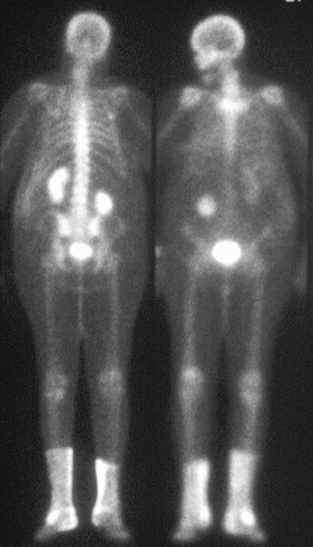Case Author(s): Ed Grishaw, M.D. and Barry A. Siegel, M.D. , 10/11/96 . Rating: #D3, #Q4
Diagnosis: Secretion of Tc-99m methylene diphosphonate (MDP) secondary to pedal hyperhidrosis
Brief history:
66-year-old woman with breast cancer, referred for bone scintigraphy to evaluate for metastatic disease.
Images:

Anterior and posterior whole body scintigrams.
View main image(bs) in a separate image viewer
View second image(bs).
If you want a hint, here is a spot image obtained after a diagnostic maneuver.
Full history/Diagnosis is available below
Diagnosis: Secretion of Tc-99m methylene diphosphonate (MDP) secondary to pedal hyperhidrosis
Full history:
66-year old woman with breast cancer and a long-standing
history of pedal hyperhidrosis (of unknown etiology).
Radiopharmaceutical:
20.0 mCi of Tc-99m MDP i.v.
Findings:
Initial delayed anterior and
posterior images of the axial and appendicular
skeleton demonstrate unusual
radiopharmaceutical accumulation in the "soft
tissues" of the feet, ankles, and lower calves in
the distribution of the patient's stockings. A
repeat anterior image after removal of the
stockings demonstrates disappearance of most of the
abnormal activity. Moderately intense
abnormal tracer uptake persists
within the left mid foot corresponding to
degenerative changes demonstrated on plain
radiographs (not provided). No evidence for skeletal
metastatic disease is seen.
Discussion:
Radioactive contamination of the body surface or clothing may occur
secondary to accidental spillage or secondary to excretion/secretion of
tracer or its metabolites by the body.
Differentiation from soft tissue uptake may be
achieved by removing the patient's clothing,
cleansing the contaminated area, and repeat
imaging.
Hyperhidrosis occurs as either a generalized or
localized phenomenon. Localized hyperhidrosis
most frequently involves the palms, soles, and
intertriginous areas (i.e., axillae, inguinal folds,
and perineal areas). Most localized cases are
secondary to emotional stimuli. Less common
causes include tabes dorsalis, hemiplegia, and
unilateral nerve disorders.
The mechanism for such substantial Tc-99m MDP secretion in sweat is
unknown. Sweat contains trace quantities of phosphate, but significant
concentrations of chloride. It is possible that
Tc-99m MDP is secreted by sweat glands in a fashion similar
to phoshphate ion. Alternatively, Tc-99m pertechnetate may
be handled similar to chloride ion by the sweat
glands, and this could be the radiochemical form of the tracer.
Tc-99m pertechnetate excretion is felt
to be unlikely in this patient because of the
absence of activity within the salivary glands,
thyroid, or stomach.
Case contributed by Paul Kountz, M.D., Redmond Regional Medical Center,
Rome, GA
References:
1) Ajmani, et al. J Nucl Med 1976;18:801-802.
2) Domonkos. Andrews' Diseases of the Skin.
Philadelphia, Saunders, 1971; pp 9-10.
3) Carruthers. Biochemistry of the Skin in
Health and Disease. Springfield, Il, CC Thomas,
1962; pp 131-157.
Followup:
None
Major teaching point(s):
See Discussion
Differential Diagnosis List
Urine contamination; venous occlusion secondary to
tight stockings.
ACR Codes and Keywords:
References and General Discussion of Bone Scintigraphy (Anatomic field:Skeletal System, Category:Misc)
Search for similar cases.
Edit this case
Add comments about this case
Read comments about this case
Return to the Teaching File home page.
Case number: bs065
Copyright by Wash U MO

